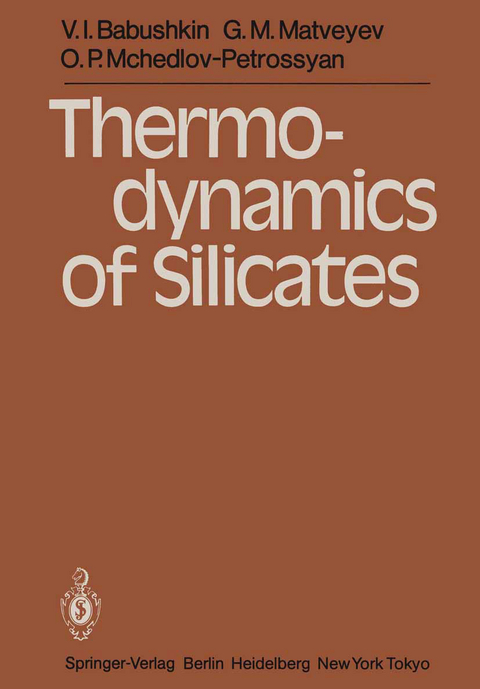
Thermodynamics of Silicates
Springer Berlin (Verlag)
978-3-642-69322-9 (ISBN)
I. The Basic Concepts and Laws of Thermodynamics.- 1 Basic Concepts of Thermodynamics.- 2 The First Law of Thermodynamics: Thermochemistry.- 3 The Second Law of Thermodynamics.- 4 Methods of Thermodynamics.- 5 The Third Law of Thermodynamics.- 6 Chemical Equilibrium and the Principles of Calculating It.- 7 Phase Equilibria.- 8 Phase Diagrams.- 9 Methods of Obtaining Initial Thermodynamic Data.- 10 The Calculation of ?G =f(T) of Reactions in Silicate Systems Based on Simple Thermodynamic Data.- 11 The Peculiarities of Applying the Methods of Chemical Thermodynamics to Silicate Systems.- II. Pyrosilicate Reactions.- 1 General Principles.- 2 The Thermodynamic Analysis of the Silicate Formation Reactions in Binary and Ternary Systems.- 3 Reactions in the Firing of Ceramics and Refractories.- 4 Reactions of Glass Formation and Devitrification.- 5 Reactions Proceeding During Firing Binders.- 6 Instances of Using Thermodynamic Calculations for Solving Other Problems of the Study of Materials.- III. Hydration Reactions.- 1 General.- 2 The Basic Properties and Thermodynamic Stability of Water.- 3 Gypsum Hemihydrate Hydration and Hydrolysis Reactions.- 4 Reactions in the System CaO-H2O.- 5 Reactions in the System SiO2-H2O.- 6 Reactions in the Systems CaO-SiO2-H2O, ?-2 CaO SiO2-H2O and 3CaO SiO2-H2O.- 7 Reactions of Hydration of Calcium Aluminates and of Iron-Containing Phases of Portland Cement Clinker.- 8 Reactions in the System MgO-SiO2-HaO.- 9 Thermochemistry and the Energy Principles of the Cement Hydration Processes.- 10 A Calculation of Colloid-Chemical Equilibria in the Systems Binder-Water.- IV. Corrosion Reactions.- 1 Reactions of the Interaction of the Constituents of Cement Stone and Concrete with Acid Gases.- 2 Reactions of the Interaction of the Constituents ofCement Stone and Concrete with Hydrogen Ions.- 3 Corrosion Resistance of Aluminium and Iron-Containing Phases of Cement Stone in Sulphate Media.- 4 Reactions in the Acid-Sulphate Corrosion of Concrete.- V. Thermodynamics of Irreversible Processes.- 1 Local Macrocharacteristics of a System, Conservation Laws and Balance Equations.- 2 The Second Law of Thermodynamics, Local Equilibrium and the Entropy Balance Equation.- 3 The Linear Thermodynamics of Irreversible Processes.- 4 The Application of the Thermodynamics of Irreversible Processes to the Study of Silicate Systems.- References.- Appendix 1. Standard Enthalpies, Gibbs Free Energies and Heat Capacity Equations of Some Elements, Simple Substances and Compounds.- Appendix 2. Thermodynamic Properties of Ions and Molecules in Aqueous Solutions.- References to Appendices 1 and 2.- Appendix 3. The Heats of Polymorphic Transitions and Melting.- References to Appendix 3.- Author Index.
| Erscheint lt. Verlag | 7.12.2011 |
|---|---|
| Mitarbeit |
Chef-Herausgeber: O.P. Mchedlov-Petrossyan |
| Übersetzer | B.N. Frenkel, V.A. Terentyev |
| Zusatzinfo | XVI, 459 p. |
| Verlagsort | Berlin |
| Sprache | englisch |
| Maße | 170 x 244 mm |
| Gewicht | 826 g |
| Themenwelt | Naturwissenschaften ► Chemie ► Anorganische Chemie |
| Naturwissenschaften ► Geowissenschaften ► Geologie | |
| Naturwissenschaften ► Geowissenschaften ► Mineralogie / Paläontologie | |
| ISBN-10 | 3-642-69322-9 / 3642693229 |
| ISBN-13 | 978-3-642-69322-9 / 9783642693229 |
| Zustand | Neuware |
| Haben Sie eine Frage zum Produkt? |
aus dem Bereich


